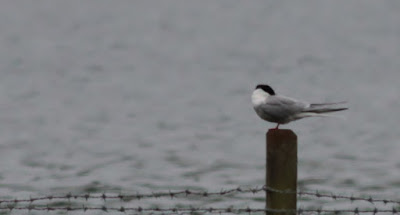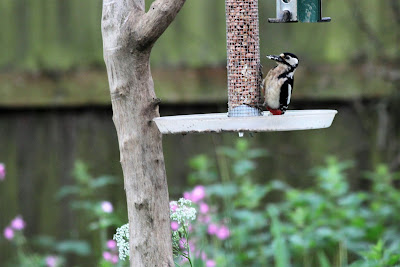Rambla de Almanzora & Vera Playa
Wednesday 24th May 2017
There
was no trip last week for a number of reasons, one being that they
found I had a blocked artery, so I now have another stent fitted and
hopefully everything will be okay. First a bit of bird news. Barrie and Beryl found some Trumpeter Finches just north of Carboneras, near
to the illegal hotel. They're getting closer! Now today's report :-
With
Gilly working again (Bless her!) I left home early to check out the
Rambla de Almanzora from Desert Springs golf complex down to the ford
meeting place. As I was preparing myself at the start (putting
binoculars round my neck) I saw a Iberian Grey Shrike high up on the
power line above me and a Jackdaw flew by. Up this end there was still
some pools of various sizes. Almost all of them contained Black-winged
Stilts and Mallards in eclipse plumage and many with ducklings. The
only other wader I saw was a Kentish Plover. There was a constant fly
past of Common Swift, Barn and Red-rumped Swallows and House Martin.
Other birds included a solitary Bee-eater, Moorhen, House Sparrow,
Spotless Starling and Goldfinch. I reached the ford with plenty of
time to spare so I continued to the road bridge, hearing Reed Warblers
in the beds below me. I crossed over and headed to the beach passed
the now disused pumping station. Nothing really down there, but on the
way back I saw a pair of Stone Curlew landing in a barren field near the
road. Retracing my steps towards the ford I added a Black-headed Gull.
At the ford itself there were Black-winged Stilt, a Little Ringed Plover
with chick plus families of Mallard. As I was waiting for the others to
arrive I also saw Magpie and Collared Dove.
Barrie and Beryl were first to arrive, followed by Paul and Kath, John,
Les, Colin (Best wishes to Sandra who had a fall and injured her
wrist/arm on Monday) and finally Jacky. Thank you to Kath for allowing
me to press-gang her to be scribe for the day. The first birds we saw
were basically a repeat of what I had already observed. As we were
chatting, John said he'd only seen his first Great Spotted Cuckoo of the
year last week. Within a minute I found one perched in a tobacco plant.
We heard then saw a Sardinian Warbler. Les spotted a Greenfinch. We saw
more Bee-eaters. A Cetti's Warbler was heard. I found a Serin near the
sewage works. On the pool there, Paul found a Ringed Plover. On the main
pool there was a Little Grebe. Resting on the graveled surround were
Mallard and a male Common Pochard. A Crested Lark flew to a traffic
sign on the far side. Then I caught sight of a Grey Wagtail in flight.
It landed near the weir. Some saw it through the vegetation, but not me.
A Blackbird flew low over the shrubs and Jacky was the first to see
the flying Hoopoe. We first heard a Stone Curlew call, then it flew,
landing near the shrubs by the broken down concrete rambla wall. We
walked back to vehicles and headed for Villaricos village for coffee.
Suitably refreshed we made our way to the beach. John saw a Kestrel on the way and Barrie got a Black Wheatear.
The
sea was quite rough with waves breaking over the harbour rocks. No
birds there, but there was a Little Egret adjacent to the beach. A
Yellow-legged Gull flew by. I saw what I thought was a Cormorant feeding
in the breakers further along the beach. Moving over to the near end of
the estuary, a Zitting Cisticola was heard. Barrie and Les then said
my Cormorant was in fact a juvenile Shag. On the estuary water there
were only Moorhen and Coot. John spotted some Audouin's Gulls on the
distant beach. As we began to make for the beach a Turtle Dove was seen
perched in a tree. It took off for a display flight and was joined by
his mate. They landed in the dense shrubs. Jacky then spotted a flying
Purple Heron which must have been on the waters edge just below us. It
flew into the reeds opposite. At the shallows at the beach end of the
estuary we saw Kentish Plover and Little Egret. There were 5 Audouin's
Gull at rest. Three Turnstone flew along the shoreline. The Shag was
still out to sea but moving further away. Tried and failed to get a
record shot. We were surprised to that the resident Whimbrel was still
there on the rocks despite the breaking waves and the ever increasing
numbers of holiday makers.
Saying
good bye to Colin, we made for the dual carriageway opposite the Consum
supermarket behind Vera Playa. There were shed loads of noisy Black-winged Stilt plus Mallard and Coot. There were Common Pochard and
White-headed Duck, some with ducklings. Eventually three Grey Heron were
seen. Barrie spotted a magnificently plumaged Black-necked Grebe. I
checked the number of Black-headed Gulls sitting on nests. I reckon
35-45 in total plus on Little Egret sitting as well. I said my goodbyes
at this point and headed home, only to get an email from Barrie to say
a Hobby appeared just after I left. Don't you just hate it when that
happens!
We ended up with 50 species. A really good days birding in good company.
Regards, Dave
Check out the accompanying website at http://www.birdingaxarquia.weebly.com for the latest sightings, photographs and additional information.





















































